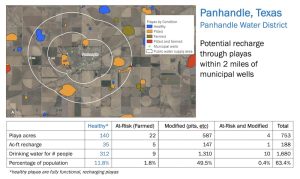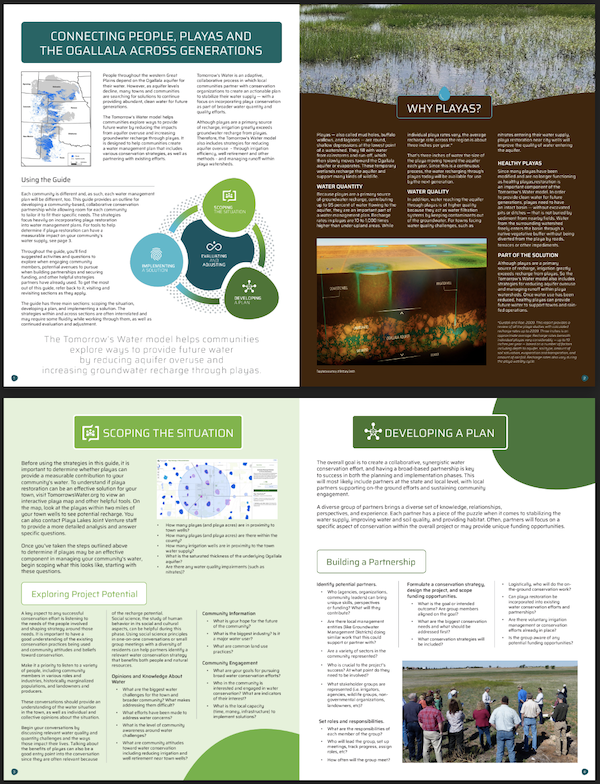 Because playas are a primary source of groundwater recharge, they can be an important part of a sustainable approach to securing water for communities in the western Great Plains. Aquifer levels are decreasing throughout the region, with many towns and communities that depend on the Ogallala aquifer at risk for continuing groundwater loss. These towns are facing a future water supply that may be limited and searching for solutions to continue providing abundant, clean water for residents.
Because playas are a primary source of groundwater recharge, they can be an important part of a sustainable approach to securing water for communities in the western Great Plains. Aquifer levels are decreasing throughout the region, with many towns and communities that depend on the Ogallala aquifer at risk for continuing groundwater loss. These towns are facing a future water supply that may be limited and searching for solutions to continue providing abundant, clean water for residents.
Communities can proactively address a declining municipal water supply by reducing the impacts from aquifer overuse and increasing groundwater recharge through playas. Once water use has been reduced, healthy playas can provide a sustainable source of future water.
Playas across the region recharge at an average annual rate of about three inches per year* — that’s three inches of water the size of the playa moving toward the aquifer each year there is adequate rainfall. For example, a four-acre playa, which is a very small one, sends approximately an acre-foot of water toward the aquifer. That’s 325,851 gallons of water, more than enough to supply a couple of families for a year.
The benefit goes beyond simple recharge; playas clean the water as it travels toward the aquifer. Studies show that water reaching the aquifer through playas is of higher quality than that going through other pathways. This happens in two ways: first, as rainfall and runoff travel toward the playa, the surrounding grasses trap sediments, which can carry contaminants into the playa; then, as the water moves through the clay floor of the playa, a second ‘cleaning’ process occurs as the soils beneath the playa remove nitrates and other dissolved contaminants. To see how this happens, watch our How Playas Work video.
*Gurdak and Roe, 2009. This report provides a review of all the playa studies with calculated recharge rates up to 2009. Three inches is an approximate average.
Enhancing Your Community’s Water
Because playas are a primary source of groundwater recharge, they are an important part of a water management plan. Once water use has been reduced, healthy playas can provide future water to support towns and rain-fed operations. Learn how in the video below.
Tomorrow’s Water
Tomorrow’s Water is an adaptive, collaborative process in which local communities partner with conservation organizations to create an actionable plan to stabilize their water supply — with a focus on incorporating playa conservation as part of broader water quantity and quality efforts. Each community is different and, as such, each water management plan will be different, too.
Tomorrow’s Water helps communities explore ways to provide future water by reducing the impacts from aquifer overuse and increasing groundwater recharge through playas.
Although playas are a primary source of recharge, irrigation greatly exceeds recharge from playas. Tomorrow’s Water is designed to help communities design a water management plan that includes reducing aquifer overuse — through irrigation efficiency, well retirement and other methods — as well as restoring playas, and managing runoff within playa watersheds.
To help communities get started, PLJV has developed a set of resources and tools — including interactive playa maps and recharge estimators, videos, printable playa maps and handouts, and a playa restoration guide — to help communities explore how to incorporate playas into water management plans.
The first step is to determine whether playas can provide a measurable contribution to your community’s water. To understand if playa restoration can be an effective solution for your town, use our Playa Recharge Estimator to view the playas within two miles of your town and their potential recharge.
If there are a number of playas, the next step is to have PLJV staff develop a more detailed analysis including the location of town wells, condition of playas within two miles of those wells, and the potential recharge if all playas were restored. Use the form on our Contact Us page (choose Tomorrow’s Water as the topic) to talk with someone about Tomorrow’s Water and to get an analysis of potential recharge through playas to support your town.
Community Engagement Guide
The PLJV partnership has developed a guide to help communities develop adaptable solutions to enhance groundwater recharge and water management. This guide provides an outline for developing a community-based, collaborative conservation partnership while allowing room for each community to tailor it to fit their specific needs. The strategies focus heavily on incorporating playa restoration into water management plans.
The guide has three main sections: scoping the situation, developing a plan, and implementing a solution. Throughout, you’ll find suggested activities and questions to explore when engaging community members, potential avenues to pursue when building partnerships and securing funding, and other helpful strategies partners have already used.
Download a PDF of the Tomorrow’s Water Community Engagement Guide now.
Incorporating Playas Into a Water Plan

In this example, the potential recharge through playas within 2 miles of town wells is enough drinking water for 63% of the population in Panhandle, Texas.
It is also important to reduce or eliminate competing water use. Although playas are a primary source of recharge, withdrawals from irrigation greatly exceed recharge from playas. However, some towns have found that when nearby irrigation is reduced or turned off, water levels in the aquifer rebound. Around the region, people are talking about and experimenting with how to lessen the amount of water used for irrigation and may be interested in programs which offer technical and financial support to retire irrigation wells near towns and municipal wells.
WE CAN HELP
Learn more about Tomorrow’s Water, and how playas can be part of your community’s water management plan. We can help guide communities through the process of scoping the situation, developing a plan, and implementing a solution.


